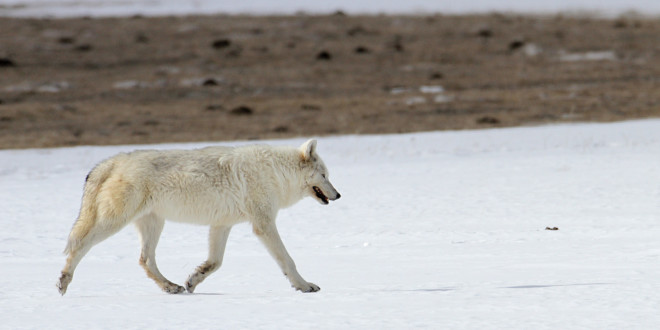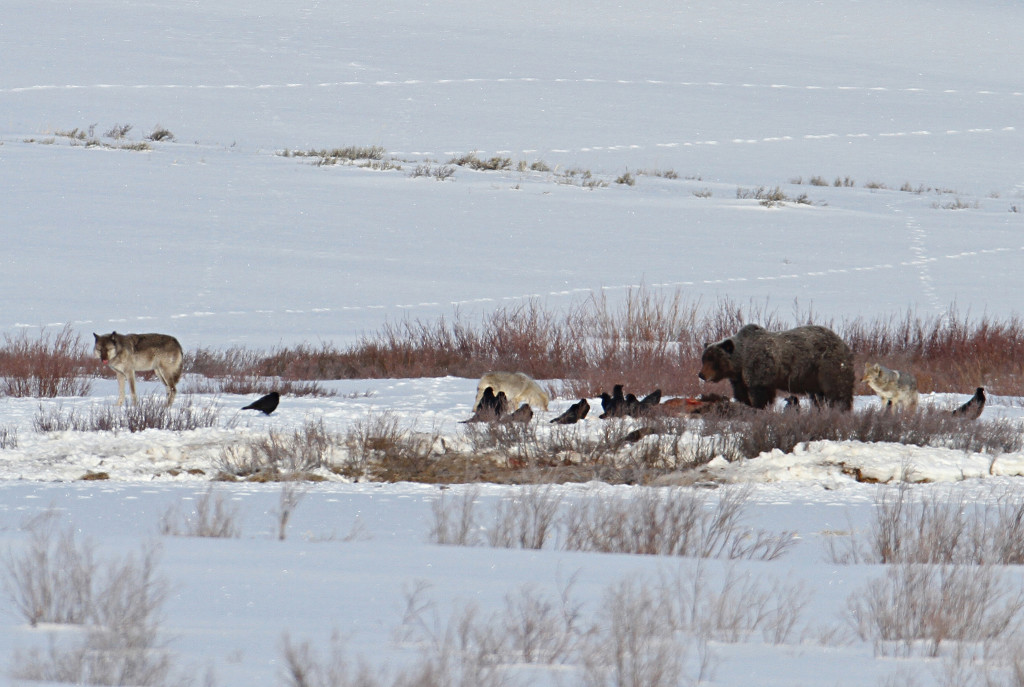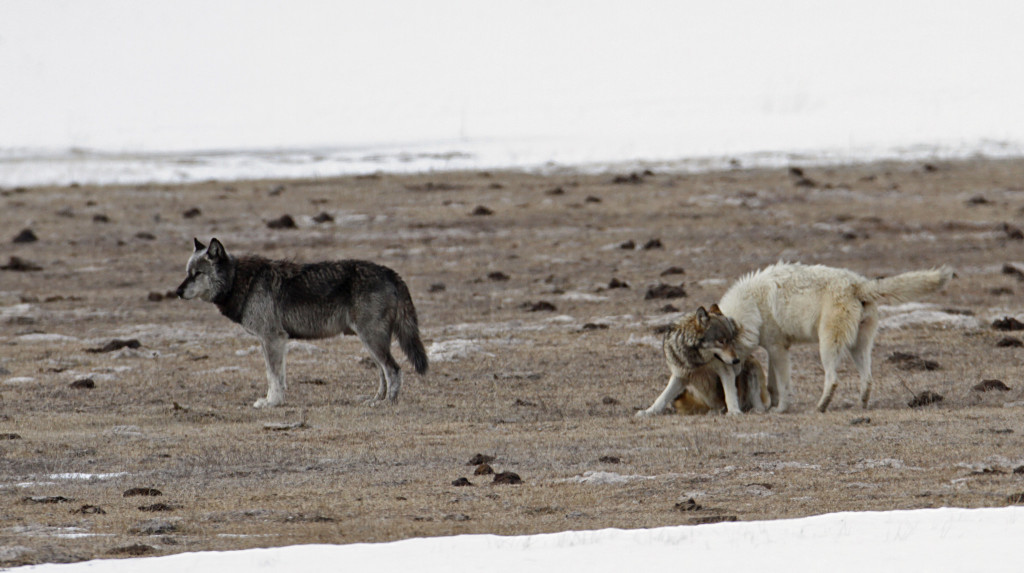In Yellowstone’s wolf population, mange is causing more than fur loss. It’s causing wolves to lose body heat and alter their habits.
Indeed, it’s happening at the worst possible time: winter, when body heat translates most clearly to survival.
In a new study published through Ecology, Bozeman-based USGS Northern Rocky Mountain Science Center ecologist Paul Cross goes through several fascinating findings, derived from six years spent studying wolves with thermal imaging cameras, which you can see below.
“It’s a very complicated paper, highly mathematical, but the gist of it is that when wolves get mange they lose a lot of heat,” said Doug Smith, wolf biologist for Yellowstone National Park, to the Billings Gazette.
Mange is caused by small mites burrowing under the skin and causing irritation. In severe enough cases, an infected animal will scratch their fur off, trying to get the mites out. In extremely severe cases, animals like wolves can lose up to a third of their coat.
The implications reach farther than just fur loss, however. Mange dramatically alters a wolf’s travel habits—and could impact the ways wolves approach hunting/feeding. From the Gazette:
To conserve energy, the mangy wolves tended to travel less in a day. The animal with the worst infection did not travel at all during the night, when it would have been colder. That’s contrary to healthy wolves which travel more at night.
“Which is maybe what you would expect if it was trying to conserve heat,” Cross said.
The study also found that although cold weather demands that an animal burn more calories to stay warm, wind had an even more chilling effect.
Previous studies by Cross have shown that wolves living in larger packs are better at surviving the ill effects of mange, possibly because the larger packs can provide enough food to sustain the animals through a tough winter.
The studies have also raised other questions that future research may be able to answer. To feed that increased caloric need, will the infected wolves try to kill more elk, their main food source? Or will they simply stay on a carcass longer and eat it more completely?
One calculation in Cross’ study showed that if eight out of 40 wolves (20 percent) had mange the increase in caloric need would amount to the energy supplied from consuming 12 additional cow elk each winter.
Trophic Cascades
Another interesting takeaway from Cross’ paper is how mange mites create a trophic cascade in Yellowstone’s ecosystem.
Recall elementary school, when you learned about the food web. Trophic cascades follow the same format but reach different conclusions. Whereas a food web teaches you about how organisms eat (grass photosynthesizes sunlight for energy, the rabbit eats grass, the fox/hawk eats the rabbit, the fox/rabbit gets decomposed by mushrooms to become soil, which grows the grass), trophic cascades essentially dramatize ecology beyond simple consumption.
The most famous example of a trophic cascade in Yellowstone is the reintroduction of wolves in 1995-96. To wit: as wolves preyed on elk, elk numbers went down, which meant less vegetation was browsed each year, which led to more vegetation, which led to more water being retained in soil and roots, which created other ecosystem changes.
When wolves were reintroduced into the ecosystem, they created changes, which were felt throughout the system. Indeed, one of the hallmarks of the theory is that certain animals create more “cascades” than others. These are known as “keystone species,” as they help an ecosystem keep its “shape” or its connections intact. Just like how a keystone keeps a stone arch from collapsing. It’s the essential piece.
One of the challenges of classifying so-called keystone species, however, is balancing the supposed “essentialness” of a species with the mutability of ecosystems. Or to put it more simply: ecosystems aren’t arches that need one part to keep from collapsing. They change all the time.
Another problem is the fact that most keystone species are just as susceptible to predation and environmental impacts as the other organisms they supposedly keep in check.
Indeed, Cross theorized that the mangy mites could someday be seen as an important predator in Yellowstone’s ecosystem. From the Gazette:
The effects of a major predator, like wolves, created what’s called a trophic cascade. But what happens when megafauna like wolves become the prey of a much smaller predator, such as the mites that cause sarcoptic mange?
Future research might also reveal another trophic cascade with mites as the top predators, Cross theorized. That won’t be an easy task.
“Simultaneous to mange in the park the elk populations were declining, the climate is changing, it’s hard to figure out how much anything is affecting each factor because they are all moving,” Cross said.
Mange was introduced into the Northern Rockies in the early 1900s by the Montana state wildlife veterinarian in an attempt to help eradicate wolves and coyotes. The disease persists in coyotes and foxes. After being reintroduced to Yellowstone wolves were free of mange until 2007.
“It is ironic that a parasite originally introduced to help eradicate wolves may increase their effects upon prey populations a century later and is potentially one more in a long list of unintended consequences in wildlife management,” the “Ecology” paper stated.
Lamar Canyon Pack
The Gazette adds that while the Lamar Canyon pack is the only one currently infected with mange, it has infected nearly every adult wolf and likely contributed to the deaths of the pack’s six pups. The worry now is that the Lamar pack will spread it to other wolves in the Park. From the Gazette:
The most recent counts of Yellowstone’s wolves show there are 79 wolves in 10 packs, down from 99 wolves at the end of December.
“That’s very typical,” Smith said, as wolves without collars move across the landscape and disappear. Pups will be born in April, once again boosting the park’s wolf population.
“The message is they seem to have the same number of pups every year,” Smith said. “The big question is how many live? Wolves die at a large rate so you need to have good wolf production for the pack sizes to remain stable.”
 Yellowstone Insider Your Complete Guide to America's First National Park
Yellowstone Insider Your Complete Guide to America's First National Park








You must be logged in to post a comment.